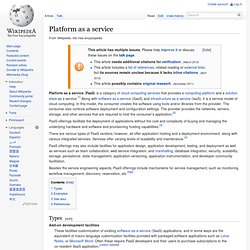

Apache Stratos. Windows Azure Websites. Joyent Cloud. Adobe Marketing Cloud. LuceraHQ on Joyent. CloudControl - German. CloudFoundry. AppScale for GAE. Jelastic. Heroku. Nodejitsu. Engine Yard. Google AppEngine. RedHat OpenShift. InstantClouds - on Joyent. PaaS. Platform as a service (PaaS) is a category of cloud computing services that provides a computing platform and a solution stack as a service.[1] Along with software as a service (SaaS) and infrastructure as a service (IaaS), it is a service model of cloud computing.

In this model, the consumer creates the software using tools and/or libraries from the provider. The consumer also controls software deployment and configuration settings. The provider provides the networks, servers, storage, and other services that are required to host the consumer's application.[2] PaaS offerings facilitate the deployment of applications without the cost and complexity of buying and managing the underlying hardware and software and provisioning hosting capabilities.[3] There are various types of PaaS vendors; however, all offer application hosting and a deployment environment, along with various integrated services. Types[edit] Add-on development facilities Stand alone development environments Examples[edit] SaaS. According to a Gartner Group estimate, SaaS sales in 2010 reached $10 billion, and were projected to increase to $12.1bn in 2011, up 20.7% from 2010.[6] Gartner Group estimates that SaaS revenue will be more than double its 2010 numbers by 2015 and reach a projected $21.3bn.

Customer relationship management (CRM) continues to be the largest market for SaaS. SaaS revenue within the CRM market was forecast to reach $3.8bn in 2011, up from $3.2bn in 2010.[7] The term "software as a service" (SaaS) is considered to be part of the nomenclature of cloud computing, along with infrastructure as a service (IaaS), platform as a service (PaaS), desktop as a service (DaaS), backend as a service (BaaS), and information technology management as a service (ITMaaS). History[edit] Centralized hosting of business applications dates back to the 1960s. The expansion of the Internet during the 1990s brought about a new class of centralized computing, called Application Service Providers (ASP).
Pricing[edit] The Twelve-Factor App. Diff b/w IaaS, PaaS & SaaS. In common usage, the term "the cloud" is essentially a metaphor for the Internet.[1] Marketers have further popularized the phrase "in the cloud" to refer to software, platforms and infrastructure that are sold "as a service", i.e. remotely through the Internet.

Typically, the seller has actual energy-consuming servers which host products and services from a remote location, so end-users don't have to; they can simply log on to the network without installing anything. The major models of cloud computing service are known as software as a service, platform as a service, and infrastructure as a service. These cloud services may be offered in a public, private or hybrid network.[2] Google, Amazon, IBM, Oracle Cloud, Salesforce, Zoho and Microsoft Azure are some well-known cloud vendors.[3] Advantages[edit] The cloud also focuses on maximizing the effectiveness of the shared resources.
Hosted (Host)services[edit] History[edit] The 1950s[edit] The 1960s–1990s[edit]